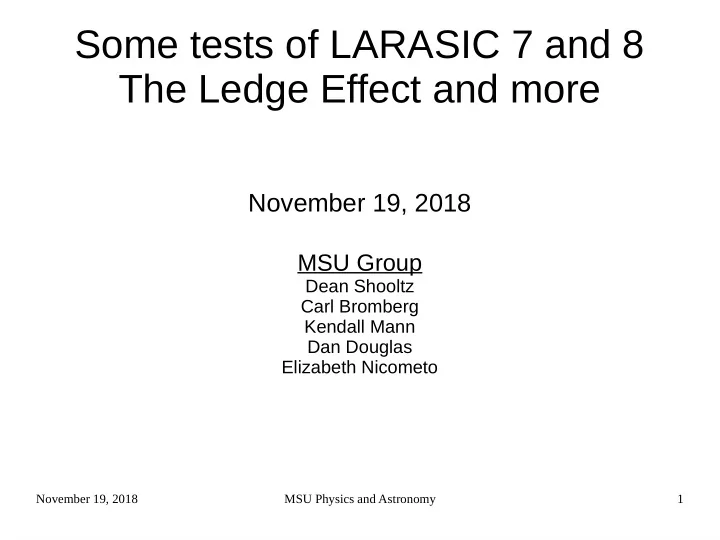

Some tests of LARASIC 7 and 8 The Ledge Effect and more November 19, 2018 MSU Group Dean Shooltz Carl Bromberg Kendall Mann Dan Douglas Elizabeth Nicometo November 19, 2018 MSU Physics and Astronomy 1
Outline Background Experimental setup Initial results Next steps November 19, 2018 MSU Physics and Astronomy 2
Characteristic shape of the “Ledge Effect” Slide copied from 10/15/2018 presentation by Hucheng Chen, Shanshan Gao, Veljko Radeka – First noticed by Tom Junk by inspection of ProtoDUNE run data – Appears when large amount of charge is delivered to LARASIC – Initial tests at BNL show that the Ledge Effect largely disappears with 900 mV baseline setting – Duration of current input also plays a role – ProtoDUNE now running with 900 mV baseline on all channels November 19, 2018 MSU Physics and Astronomy 3
Test Stand at Michigan State University Quad Socket FEASIC tester from BNL – Stretched version arrived Oct. 9 th -Thanks! –I’ve Modified firmware, C# backend, LabView – Real time control and data display (20,000 points, 5 msec) – FPGA delivers trigger to external signal generator – System handles like an oscilloscope – Can set ASIC parameters and readout traces in ~50 msec – Can set up LabView to process ~ 1000 traces/minute – Using a signal generator to send voltage ramps into FEASIC test capacitance (185 fF) 185 fF Image stolen from BNL talk 10/15/2018 November 19, 2018 MSU Physics and Astronomy 4
Look in detail at the threshold voltage required to give the Ledge Effect waveform – enabled by using a real-time system Also compare results across three generations of LARASIC November 19, 2018 MSU Physics and Astronomy 5
Perform the following tests Try 200 mV and 900 mV baseline settings – No Ledge Effect seen with 900 mV baseline setting (up to 1500 mV to test cap) – Agrees with BNL observation Try all four different gain settings – Does not change Ledge Effect Try all four different peaking time settings – Does not change Ledge Effect Try adjust neighbor channels – Does not seem to change Ledge Effect Try turning the Output Buffer ON/OFF – Does not seem to change the Ledge Effect Try adjusting the Leakage Current – This has a significant effect November 19, 2018 MSU Physics and Astronomy 6
Look in detail at the threshold voltage required to give the Ledge Effect waveform – enabled by using a real-time system Adjust the FEASIC Leakage Current setting November 19, 2018 MSU Physics and Astronomy 7
Hall of Fame: longest Ledge Effect seen in 176 tested FEASIC channels V7 chip P2-11 channel 14 Duration about 1.4 millisec November 19, 2018 MSU Physics and Astronomy 8
Ramp time can have a big influence on signal shape at 900 mV baseline Ramp voltage 1500 mV Effect is a function of ramp time and voltage: – Threshold is 320 mV at 1 usec, 1090 mV at 10 usec, 1170 mV at 20 usec 50 usec 35 usec 30 usec 25 usec 20 usec 10 usec November 19, 2018 MSU Physics and Astronomy 9
Hypersensitivity to duration of current pulse below regime of the Ledge Effect 700 mV amplitude ramp 1.5 usec 1.6 usec 1.7 usec November 19, 2018 MSU Physics and Astronomy 10
Recommend
More recommend